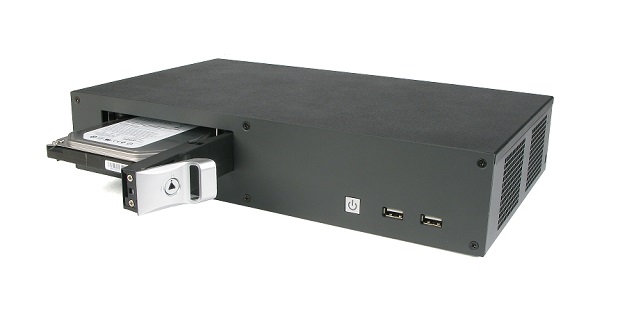Hot-Swap Storage: One Important Thing You Need to Know
Whether being used for 24/7 data gathering, 4K video surveillance or big data server applications, reliable and scalable storage solutions are a growing concern for today’s hardware users. As such, we’ve seen many of our clients moving to hot-swap hard drive management to help streamline the data storage, access and archiving process. As with all technology, changes in standards and hardware can have a far reaching impact, and one fairly recent evolution in storage technology has the potential to cause headaches for those unprepared to make the requisite adjustments.
Watch our Tech Edge video on the topic, or read on to see why the size of your hard drive isn’t just about how much data it can store.
The differences between storage drives
2.5″ SSD and HDD storage drives are available in different heights. Most of the drives that OnLogic sells are either 7mm or 9.5mm tall. While there are hot-swap bays built to accommodate different drive heights, 10mm hot-swap bays tend to be the most common. This means, if your drive is not high enough to fill the entire hot swap bay, it may not line up correctly with the corresponding SATA connector at the back of the bay.
As an additional complication, depending on the system, the hot-swap bay may need to be installed upside down. This doesn’t present any issue as long as the storage drive being used fills the entire bay, but once again, if the drive is smaller than the bay, gravity will work against you to cause a disconnect between the SATA connector and the drive.

How to fix a hard drive that’s too small
If a 7mm drive does not line up with the SATA connector in the hot swap bay, you can use a 2.5mm spacer to fill the rest of the space. The spacer is simply attached to the drive and makes the effective height of the drive 9.5mm, ensuring proper contact with the drive connector.
How to choose the right storage drive for your hot-swap bays
 If you remove and reinsert a hard drive into a hot swap bay, and it’s no longer detected by the system, look for extra room between the drive and the top of the bay. If you look into the bay, you may see the internal SATA connector. If possible you may be able to simply flip the system over and insert the drive, but this isn’t always a practical solution. At OnLogic, we add spacers to our 7mm drives to ensure proper fit in 9.5mm hot-swap bays. Alternatively, you can purchase 9.5mm tall drives, but understanding the differences between hot-swap bays and storage drives will help you avoid this type of frustration.
If you remove and reinsert a hard drive into a hot swap bay, and it’s no longer detected by the system, look for extra room between the drive and the top of the bay. If you look into the bay, you may see the internal SATA connector. If possible you may be able to simply flip the system over and insert the drive, but this isn’t always a practical solution. At OnLogic, we add spacers to our 7mm drives to ensure proper fit in 9.5mm hot-swap bays. Alternatively, you can purchase 9.5mm tall drives, but understanding the differences between hot-swap bays and storage drives will help you avoid this type of frustration.
Real world examples of how hot-swap storage
Let’s say your system has two identical hard drives, which you’ve configured into a RAID 1 array (learn more about RAID here). This means the saved data is identical on both drives. This mirroring is a great failsafe against system downtime because if one drive crashes you’ll still have all of your data on the other drive. Pairing this with a separate backup solution provides both high availability and high reliability. By utilizing a hot-swap system you can easily change out a drive should one fail or remove one of the drives without interrupting the data writing on the other drive.
In another example, let’s say your business runs all the same software on all of the computers on your factory floor. In many manufacturing facilities, the most common point of hardware failure is hard drives. Airborne contaminants, extreme temperatures and exposure to high levels of vibration can all contribute to hard drive failure, particularly if you aren’t utilizing a solid state storage option. Without a hot-swap solution you lose hours of time when a hard drive fails because you have to remove the mounted system, send it to IT, wait for them to open it up, replace and test the hard drive, and reinstall the system. With a hot-swap bay you can keep multiple spare preconfigured hard drives on hand, and swap them out on the floor, saving your business an incredible amount of time and money.
Have questions? Connect with our team
Because of the flexible nature of SATA drives, hot-swappable HDDs or SSDs are a great option for a huge range of applications. But as with any hardware feature, it’s important to understand the limitations and potential stumbling blocks. If you have questions about hot-swap storage, or any of the features of our industrial PCs, don’t hesitate to reach out to one of our Solutions Specialists.
Note: this blog was originally published on May 16, 2016 and was updated on September 27th, 2021.
Get the Latest Tech Updates
Subscribe to our newsletters to get updates from OnLogic delivered straight to your inbox. News and insights from our team of experts are just a click away. Hit the button to head to our subscription page.
Share
More Articles
OnLogic Industrial Computers
Discover OnLogic's multitude of industrial computers that will help you to advance your IoT project
Learn more at OnLogic.com
OnLogic Industrial PCs: Designed to last. Built to order. Delivered in days. Visit our online store at OnLogic.com





